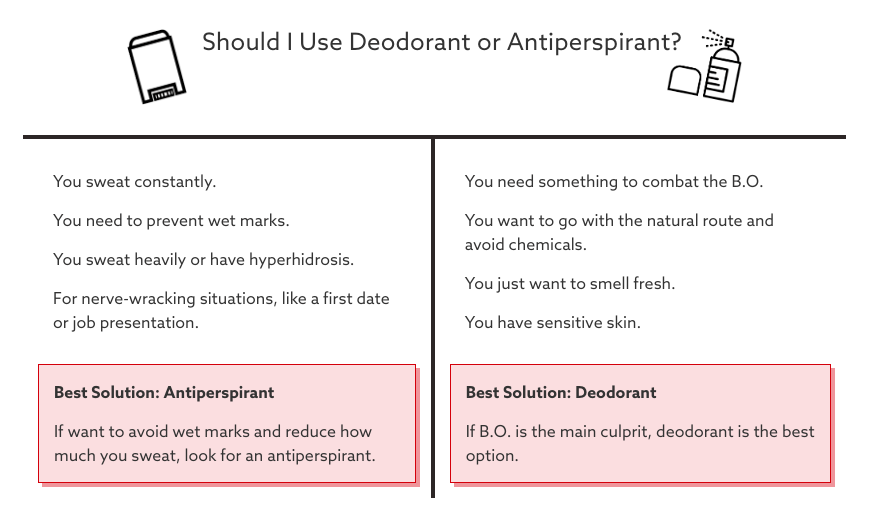HOW TO USE ANTIPERSPIRANT
Antiperspirant is potent, so make sure you’re applying it correctly and carefully. Follow these tips for best results:- Apply antiperspirant after showering or the night prior before going to bed (when your sweat glands are least active). Swiping it on right before you head out the door won’t cut it, because the active ingredients need time to kick in.
- You can try gently patting or massaging antiperspirant into your skin to improve its effectiveness.
- You can apply antiperspirant to areas other than the underarms (unlike deodorant).
- Most antiperspirants boast 12 to 48-hour protection, so unless you sweat heavily, you likely won’t need to reapply during the day.
- Recommendation: Keep Dry Sweat Wipe

ANTIPERSPIRANT INGREDIENTS
If your product contains any form of aluminum, it’s an antiperspirant.
Types of aluminum commonly used in antiperspirants are aluminum chlorohydrate, aluminum zirconium trichlorohydrex glycine, aluminum hydroxybromid, aluminum sulfate and sodium aluminum chlorohydroxy lactate.
While many natural ingredients like witch hazel, mineral salts, hops, baking soda and talc may reduce sweat, aluminum is the only ingredient recognized by the FDA as an antiperspirant. Anything labeled “aluminum-free antiperspirant” isn't guaranteed to stop sweat.

WHICH IS THE BEST ANTIPERSPIRANT?
Antiperspirant is available in many forms, including aerosol sprays, sticks, creams, gel, roll-on or solid sticks. But no matter what application method you choose or prefer, your antiperspirant ultimately needs to be effective at reducing sweat and preventing pit stains.
SO WHAT'S THE DEAL WITH DEODORANT-ANTIPERSPIRANTS?
Most brands use the term deodorant interchangeably to describe antiperspirants and deodorants. Antiperspirants that contain fragrance (to minimize body odor) are called deodorant-antiperspirants, or combination deodorants and antiperspirants.
Take Secret’s Clinical Strength Invisible Solid Deodorant. It sports a deodorant label. But if you read the description, you’ll see one of its primary functions is “wetness protection.” It also contains an active antiperspirant ingredient called aluminum zirconium. By the FDA's definition, this product is an antiperspirant.
Now that you know the difference between deodorant vs. antiperspirant, you're probably wondering which one is best.
Antiperspirant vs. Deodorant: Which Is Right For You?
Deodorant is a cosmetic used to mask or neutralize body odor. Antiperspirant, on the other hand, is a “drug” because it temporarily blocks your sweat glands to reduce perspiration. When it comes to deciding between deodorant vs. antiperspirant, it depends on your personal preferences and sweat levels.If you’re a light sweater and want to prevent body odor, deodorant is a good option. For those who sweat heavily or get substantial underarm sweat stains day in and day out, antiperspirant is the way to go.
Lastly, it’s important to note that deodorant-antiperspirants appear to combine the best of both worlds, but overall, they may not be as effective. You might be better off using a separate deodorant and antiperspirant together. To reap the maximum benefits of deodorant and antiperspirant, use antiperspirant before you go to bed and deodorant in the morning.


